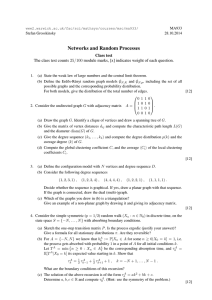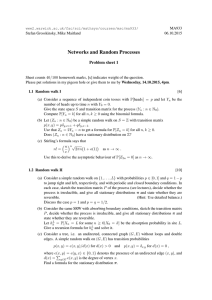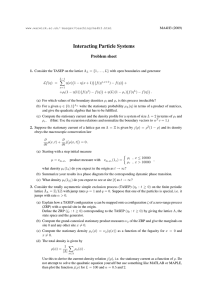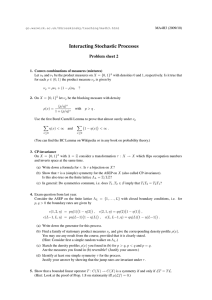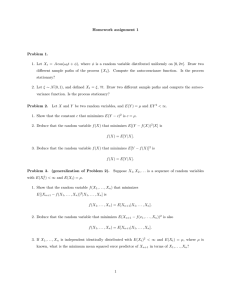Networks and Random Processes Class test
advertisement
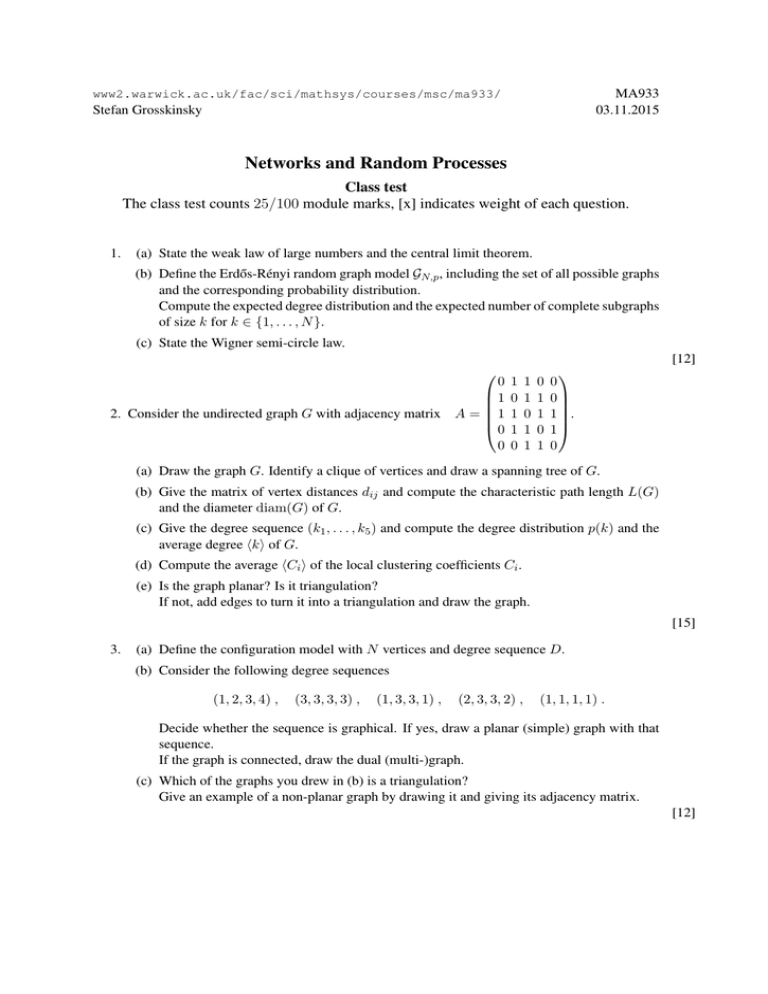
MA933
03.11.2015
www2.warwick.ac.uk/fac/sci/mathsys/courses/msc/ma933/
Stefan Grosskinsky
Networks and Random Processes
Class test
The class test counts 25/100 module marks, [x] indicates weight of each question.
1.
(a) State the weak law of large numbers and the central limit theorem.
(b) Define the Erdős-Rényi random graph model GN,p , including the set of all possible graphs
and the corresponding probability distribution.
Compute the expected degree distribution and the expected number of complete subgraphs
of size k for k ∈ {1, . . . , N }.
(c) State the Wigner semi-circle law.
[12]
0
1
2. Consider the undirected graph G with adjacency matrix A =
1
0
0
1
0
1
1
0
1
1
0
1
1
0
1
1
0
1
0
0
1
.
1
0
(a) Draw the graph G. Identify a clique of vertices and draw a spanning tree of G.
(b) Give the matrix of vertex distances dij and compute the characteristic path length L(G)
and the diameter diam(G) of G.
(c) Give the degree sequence (k1 , . . . , k5 ) and compute the degree distribution p(k) and the
average degree hki of G.
(d) Compute the average hCi i of the local clustering coefficients Ci .
(e) Is the graph planar? Is it triangulation?
If not, add edges to turn it into a triangulation and draw the graph.
[15]
3.
(a) Define the configuration model with N vertices and degree sequence D.
(b) Consider the following degree sequences
(1, 2, 3, 4) ,
(3, 3, 3, 3) ,
(1, 3, 3, 1) ,
(2, 3, 3, 2) ,
(1, 1, 1, 1) .
Decide whether the sequence is graphical. If yes, draw a planar (simple) graph with that
sequence.
If the graph is connected, draw the dual (multi-)graph.
(c) Which of the graphs you drew in (b) is a triangulation?
Give an example of a non-planar graph by drawing it and giving its adjacency matrix.
[12]
4. Kingman’s coalescent
Consider a system of well mixed, coalescing particles
and let Nt be the number of particles at
time t with N0 = N . At time t ≥ 0, each of the N2t pairs of particles coalesces independently
with rate 1. This can be interpreted as generating an ancestral tree of individuals in a population
model, tracing back to a single common ancestor.
(a) Give the state space and the transition rates of the process (Nt : t ≥ 0) and write down
the master equation.
Is the process ergodic? Does it have absorbing states? Give all stationary distributions.
(b) Show that the mean time to reach the state 1 is given by E(T ) = 2 1 − N1 .
(c) Assume that each particle i ∈ {1, . . . , N } initially has a type b(i) = i (each type is
different), and that after coalescing the new particle assumes one of the two types with
equal probability.
What is the distribution of the type of the last individual once Nt = 1?
(d) Assume now that initially b(i) = A with probability p ∈ (0, 1) and b(i) = B with probability 1 − p independently across all i ∈ {1, . . . , N }, with dynamics as in (c).
What is the distribution of the type of the last individual once Nt = 1?
[12]
5. Consider
(Xt : t ≥ 0) with state space S = {0, 1}, X0 = 0 and generator matrix
the CTMC
−1 1
G=
.
2 −2
(a) Give the stationary distribution π. Is it reversible?
(b) Give the transition matrix P Y for the corresponding jump chain (Yn : n ∈ N0 ) and its
stationary distribution π Y .
(c) Compute the eigenvalues of G, and the transition matrix P (t) = exp(tG) for all t > 0.
(d) For a discrete-time sampling of (Xt : t ≥ 0) with fixed time interval ∆t > 0 let
(Zn : n ∈ N0 ) be the DTMC with Zn = Xnδt .
Give the transition matrix P Z of this chain and its stationary distribution π Y .
What is the difference between the DTMCs (Yn : n ∈ N0 ) and (Zn : n ∈ N0 )?
(Write one or two sentences.)
[12]
6. Consider the linear voter model (ηt : t ≥ 0) where individual j influences the opinion of
individual i with rate q(j, i) ≥ 0.
(a) Give the state space of the model and a formula of the transition rates c(η, η i ) using the
standard notation
η(k) , k 6= i
i
η (k) =
for configurations where the opinion of individual i is flipped.
1 − η(k) , k = i
(b) Is the process ergodic (justify your answer)?
Give a formula for all stationary distributions of the process, assuming that q(j, i) is irreducible.
(c) For q(j, i) = λ(δi+1,j + δi−1,j ), λ > 0 and i, j ∈ {1, . . . , 5} (5 individuals) sketch the
graphical representation of the model using independent Poisson processes.
(d) Describe the steps of the random sequential update algorithm to simulate this process.
[12]
